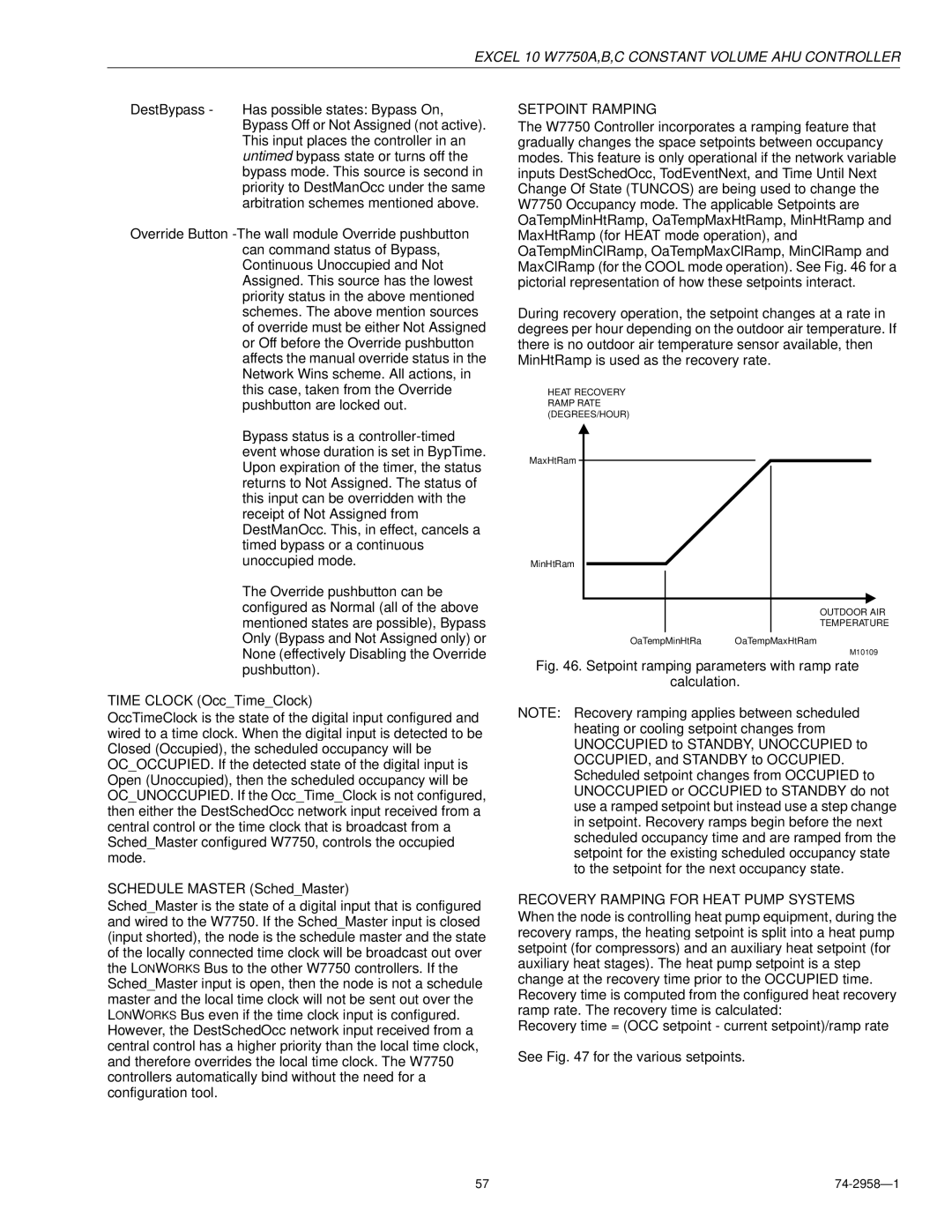
EXCEL 10 W7750A,B,C CONSTANT VOLUME AHU CONTROLLER
DestBypass - Has possible states: Bypass On, Bypass Off or Not Assigned (not active). This input places the controller in an untimed bypass state or turns off the bypass mode. This source is second in priority to DestManOcc under the same arbitration schemes mentioned above.
Override Button
Bypass status is a
The Override pushbutton can be configured as Normal (all of the above mentioned states are possible), Bypass Only (Bypass and Not Assigned only) or None (effectively Disabling the Override pushbutton).
TIME CLOCK (Occ_Time_Clock)
OccTimeClock is the state of the digital input configured and wired to a time clock. When the digital input is detected to be Closed (Occupied), the scheduled occupancy will be OC_OCCUPIED. If the detected state of the digital input is Open (Unoccupied), then the scheduled occupancy will be OC_UNOCCUPIED. If the Occ_Time_Clock is not configured, then either the DestSchedOcc network input received from a central control or the time clock that is broadcast from a Sched_Master configured W7750, controls the occupied mode.
SCHEDULE MASTER (Sched_Master)
Sched_Master is the state of a digital input that is configured and wired to the W7750. If the Sched_Master input is closed (input shorted), the node is the schedule master and the state of the locally connected time clock will be broadcast out over the LONWORKS Bus to the other W7750 controllers. If the Sched_Master input is open, then the node is not a schedule master and the local time clock will not be sent out over the LONWORKS Bus even if the time clock input is configured. However, the DestSchedOcc network input received from a central control has a higher priority than the local time clock, and therefore overrides the local time clock. The W7750 controllers automatically bind without the need for a configuration tool.
SETPOINT RAMPING
The W7750 Controller incorporates a ramping feature that gradually changes the space setpoints between occupancy modes. This feature is only operational if the network variable inputs DestSchedOcc, TodEventNext, and Time Until Next Change Of State (TUNCOS) are being used to change the W7750 Occupancy mode. The applicable Setpoints are OaTempMinHtRamp, OaTempMaxHtRamp, MinHtRamp and MaxHtRamp (for HEAT mode operation), and OaTempMinClRamp, OaTempMaxClRamp, MinClRamp and MaxClRamp (for the COOL mode operation). See Fig. 46 for a pictorial representation of how these setpoints interact.
During recovery operation, the setpoint changes at a rate in degrees per hour depending on the outdoor air temperature. If there is no outdoor air temperature sensor available, then MinHtRamp is used as the recovery rate.
HEAT RECOVERY |
|
RAMP RATE |
|
(DEGREES/HOUR) |
|
MaxHtRam |
|
MinHtRam |
|
| OUTDOOR AIR |
| TEMPERATURE |
OaTempMinHtRa | OaTempMaxHtRam |
| M10109 |
Fig. 46. Setpoint ramping parameters with ramp rate
calculation.
NOTE: Recovery ramping applies between scheduled heating or cooling setpoint changes from UNOCCUPIED to STANDBY, UNOCCUPIED to OCCUPIED, and STANDBY to OCCUPIED. Scheduled setpoint changes from OCCUPIED to UNOCCUPIED or OCCUPIED to STANDBY do not use a ramped setpoint but instead use a step change in setpoint. Recovery ramps begin before the next scheduled occupancy time and are ramped from the setpoint for the existing scheduled occupancy state to the setpoint for the next occupancy state.
RECOVERY RAMPING FOR HEAT PUMP SYSTEMS
When the node is controlling heat pump equipment, during the recovery ramps, the heating setpoint is split into a heat pump setpoint (for compressors) and an auxiliary heat setpoint (for auxiliary heat stages). The heat pump setpoint is a step change at the recovery time prior to the OCCUPIED time. Recovery time is computed from the configured heat recovery ramp rate. The recovery time is calculated:
Recovery time = (OCC setpoint - current setpoint)/ramp rate
See Fig. 47 for the various setpoints.
57 |
|
